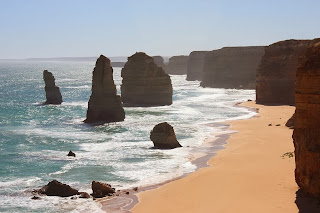A compendium of interesting places, hidden wonders, Beautiful Places, strange travel destination, tourist attractions.
Friday, 6 July 2012
12 Apostles, Victoria, Australia
The Twelve Apostles is a
collection of spectacular limestone stacks that rises up to 45 meters, 7
kilometers off the shore of the Port Campbell National Park, in
Victoria, Australia. Situated by the side of the
iconic Great Ocean Road, it is one of the most well-known highlights of
the scenic route that begins approximately 97kilometers southwest of
Melbourne and winds 150 miles along the picturesque coastline.This beautiful site was
originally famous as the Sow and Piglets until 1922 Muttonbird Island,
near Loch Ard Gorge, was the Sow, and the lesser rock stacks were the
Piglets, after which it was renamed to The
Apostles for tourism purposes. The formation ultimately became famous
as the Twelve Apostles, despite only ever having nine stacks. One of
them fell in 2005, leaving behind only eight. The Twelve Apostles were
shaped by erosion of the original coastline, which
started 10 to 20 million years ago. Persistent action of the sea on the
limestone gradually wore down the rocky cliff, gradually leaving these
pillars. The cliff is still being eroded at a rate of about 2cm each
year, and in the future is expected to form
more ‘Apostles’ from the other rocky headlands that line the Victorian
coastline.

Subscribe to:
Comments (Atom)
















































